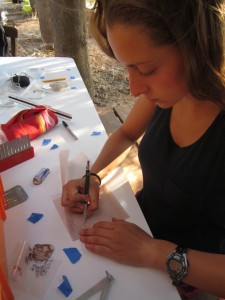(Guest post by Sarah Wilker)
The Burgaz Harbors Project 2013 season has provided me with an opportunity to learn the conventions of ceramic drawing. Drawings of pottery provide a different set of information from photographs of pottery. While photographs show exactly what a piece of pottery looks like now, a drawing can paint an accurate picture of what the piece looked like in its original pre-worn state. No drawing can recreate a piece of pottery, but it can show information no longer preserved by the piece itself.
The initial step of ceramic drawing, finding the diameter measure, can help identify a piece of pottery’s use; a very large diameter is more likely to be a plate or a large bowl, while a smaller diameter may belong to a cup or another small vessel. Depending on the amount of surviving ceramic, the diameter measure can be taken with a ruler or with a pre-existing rim chart (a chart with different circular-rim drawings already shown with their respective diameter measure). The diameter measure is drawn and noted on the sketch. Once the diameter has been taken, a center line is drawn to separate the diameter into two radii (one for each side of the piece from a two dimensional view).
The second step of a ceramic drawing is a profile of the piece. Every ceramic drawing includes a carefully taken profile. This profile can be taken with clay, a contour gauge, or another measuring device. The profile of a ceramic piece is vital for identifying the function of a piece of pottery, because every type of pottery has its own shape and set of contours. The profile is then placed on the outer left edge of the diameter.
Pottery drawings use lines to indicate sharp directional changes. On the profile side of the drawing (left) horizontal lines are used to indicate contour changes on the interior of the piece. When a piece of pottery is photographed, the current angles and contours are represented. With a drawing, one can recreate the former shape of the piece through contour lines, which can aid in the identification of a piece.
In order to make a complete drawing, the profile is flipped to the right side of the diameter. This profile, however, only indicates the outermost line of the piece (no interior contour detailing). Additionally, any horizontal contour lines on the right side of of the center line show sharp directional changes in the exterior shape.
Finally, if the piece is less than twenty five percent of its original whole, then the sherd is sketched in between the right side exterior line and the center line. If the piece is twenty five to fifty percent preserved, a rough sketch of the piece is drawn from the right outside line to the center line. If the whole piece is preserved (the entirety of the diameter), then half the piece is sketched from the exterior line to the mid line. This step unites drawing with photo; it shows what remains post-excavation next to the platonic form of the piece.
I have grown to love pottery drawing more and more throughout the Burgaz Harbors Project excavation season. While I have always loved working with pottery, ceramic drawing has taught me to look at individual pottery sherds more carefully. Additionally, the ability to use measurement and profile to make ceramic identifications is fascinating to me. I hope to continue to look at ceramics through drawing on future excavation seasons.


